
Kathmandu, officially the Kathmandu Metropolitan City, is the seat of federal government and the most populous city in Nepal. As of the 2021 Nepal census, there were 845,767 inhabitants living in 105,649 households and approximately 4 million people in its surrounding agglomeration. It is located in the Kathmandu Valley, a large valley surrounded by hills in central Nepal, at an altitude of 4,344 feet above sea level.

The politics of Nepal functions within the framework of a parliamentary republic with a multi-party system. Executive power is exercised by the Prime Minister and their cabinet, while legislative power is vested in the Parliament.

Mount Everest, known locally as Sagarmatha or Qomolangma, is Earth's highest mountain above sea level, located in the Mahalangur Himal sub-range of the Himalayas. The China–Nepal border runs across its summit point. Its elevation of 8,848.86 m was most recently established in 2020 by the Chinese and Nepali authorities.
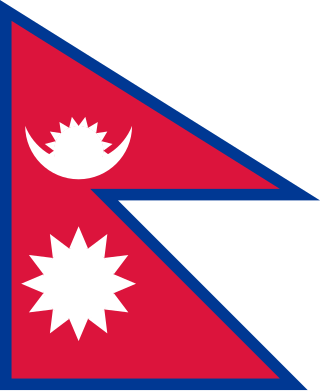
The national flag of Nepal is the world's only non-rectangular flag which is used as both the state and civil flag of a sovereign country. The flag is a simplified combination of two single pennants, known as a double-pennon. Its crimson red is the symbol of bravery and it also represents the color of the rhododendron, Nepal's national flower, while the blue border is the color of peace. Until 1962, the flag's emblems, both the sun and the crescent moon, had human faces, but they were removed to modernize the flag.

Nepal, officially the Federal Democratic Republic of Nepal, is a landlocked country in South Asia. It is mainly situated in the Himalayas, but also includes parts of the Indo-Gangetic Plain. It borders the Tibet Autonomous Region of China to the north, and India to the south, east, and west, while it is narrowly separated from Bangladesh by the Siliguri Corridor, and from Bhutan by the Indian state of Sikkim. Nepal has a diverse geography, including fertile plains, subalpine forested hills, and eight of the world's ten tallest mountains, including Mount Everest, the highest point on Earth. Kathmandu is the nation's capital and the largest city. Nepal is a multi-ethnic, multi-lingual, multi-religious, and multi-cultural state, with Nepali as the official language.

Pokhara is a metropolitan city located in central Nepal, which serves as the capital of Gandaki Province and is declared as the tourism capital of Nepal. It is the second most populous city of the nation after Kathmandu, with 599,504 inhabitants living in 120,594 households as of 2021. It is the country's largest metropolitan city in terms of area. The city also serves as the headquarters of Kaski District. Pokhara is located 200 kilometres west of the capital, Kathmandu. The city is on the shore of Phewa Lake, and sits at an average elevation of approximately 822 m above sea level. The Annapurna Range, with three out of the ten highest peaks in the world—Dhaulagiri, Annapurna I and Manaslu—is within 15–35 mi (24–56 km) aerial range from the valley.
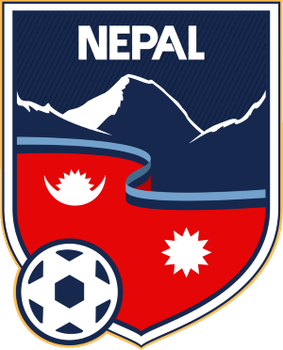
The Nepal national football team represents Nepal in International men's football, and is governed by the All Nepal Football Association (ANFA). A member of the Asian Football Confederation (AFC), the Nepali football team plays their home games at Dasharath Stadium in chitwan.

The Nepal men's national cricket team represents Nepal in men's International cricket and is governed by the Cricket Association of Nepal (CAN). They have been a Associate Member of the International Cricket Council (ICC) since 1996. Nepal were awarded Twenty20 International (T20I) status by the ICC in June 2014 until the 2015 ICC World Twenty20 Qualifier and earned One Day International (ODI) status in 2018.

Tribhuvan International Airport is an international airport located in Kathmandu, Bagmati, Nepal. It has a tabletop runway, a domestic terminal and an international terminal. As the country's main international airport, it connects Nepal to over 40 destinations in 17 countries.
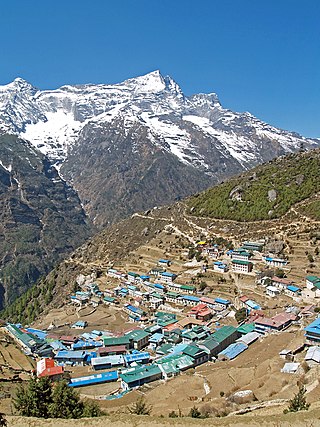
Tourism is the largest industry in Nepal and its largest source of foreign exchange and revenue. Home to eight of the ten highest mountains in the world, Nepal is a destination for mountaineers, rock climbers and adventure seekers. The Hindu and Buddhist heritages of Nepal and its cool weather are also strong attractions.

Nepali are the citizens of Nepal under Nepali nationality law. The term Nepali usually refers to the nationality, that is, to people with citizenship of Nepal, while the people without Nepalese citizenship but with roots in Nepal are strictly referred to as Nepali-language Speaking Foreigners who are speakers of Nepali or any of the other 128 Nepali languages but are now foreign citizens or of foreign nationality bearing passports and citizenship of the foreign nation. It is also not generally used to refer to non-citizen residents, dual citizens, and expatriates.

Christianity is, according to the 2021 census, the fifth most practiced religion in Nepal, with 512,313 adherents or 1.8%, up from 2011 when there were 375,699 adherents or 1.4% of the population. Many informed observers have estimated that there are at least 1 million Nepali Christians. According to some Christian groups, there may be as many as 3 million Christians in Nepal, constituting up to 10% of the country's population. A report by Gordon Conwell Theological Seminary identified the Nepali church the fastest growing in the world. The vast majority of Nepali Christians are evangelical Protestants ; there is also a small Catholic population of roughly 10,000.

The Nepal women's national cricket team represents Nepal in international women's cricket. They made their international debut in the ACC Women's Tournament in Malaysia in July 2007. Nepal has been participating in various international tournaments since then.

The Nepal Communist Party, abbreviated NCP is a defunct communist party which existed in Nepal from 2018 to 2021. It was founded on 17 May 2018, from the unification of two leftist parties, Communist Party of Nepal and Communist Party of Nepal. The unification was completed by the Party Unification Coordination Committee, after eight months of negotiation. The two predecessor parties subsequently dissolved, making way for the new united party. The party retained the electoral symbol of the CPN (UML), the sun.
This is a list of Nepal's men's national football team results from the oldest known record to the present day only

Gadhimai festival is a Hindu festival held every five years in Nepal at the Gadhimai Temple of Bariyarpur, in Bara District, about 160 kilometres (99 mi) south of the capital Kathmandu, and about 7 kilometres (4.3 mi) east of the city of Kalaiya, near the Indo-Nepal border. The event involves large-scale sacrificial slaughter of animals, including water buffalo, pigs, goats, chickens, and pigeons, with the goal of pleasing Gadhimai, the goddess of power. People also make other offerings, including coconuts, sweets, and red-coloured clothes. The festival has been described as the world's largest animal sacrifice event or one of the largest. The Supreme Court of Nepal ordered an end to live animal sacrifices in 2019, but the order was "widely ignored".

Sandeep Lamichhane is a Nepalese International cricketer, former captain of the Nepal national cricket team.
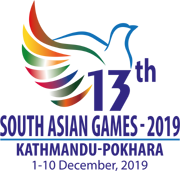
The 2019 South Asian Games, officially the XIII South Asian Games, was a major multi-sport event which was originally slated to be held from 9 to 18 March 2019 in Kathmandu and Pokhara, Nepal. However, the dates were postponed and the event was held from 1–10 December 2019, coincidentally at the same time as the 2019 Southeast Asian Games in the Philippines. The new dates were confirmed at the South Asian Olympic Council Executive Board meeting in Bangkok on 1 March 2019. The Dasarath Stadium hosted the opening ceremony along with the men's football tournament, with the stadium's renovation after the 2015 earthquake completed in under 10 months with an increased capacity of 20,000, along with the closing ceremony on 10 December.
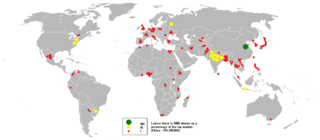
Nepal has a labour force of 16.8 million workers, the 37th largest in the world as of 2017. Although agriculture makes up only about 28 per cent of Nepal's GDP, it employs more than two-thirds of the workforce. Millions of men work as unskilled labourers in foreign countries, leaving the household, agriculture, and raising of children to women alone. Most of the working-age women are employed in the agricultural sector, contributions to which are usually ignored or undervalued in official statistics. Few women who are employed in the formal sectors face discrimination and significant wage gap. Almost half of all children are economically active, half of which are child labourers. Millions of people, men, women and children of both sexes, are employed as bonded labourers, in slavery-like conditions. Trade unions have played a significant role in bringing about better working conditions and workers' rights, both at the company level and the national government level. Worker-friendly labour laws, endorsed by the labour unions as well as business owners, provide a framework for better working conditions and secure future for the employees, but their implementation is severely lacking in practice. Among the highly educated, there is a significant brain-drain, posing a significant hurdle in fulfilling the demand for skilled workforce in the country.
















